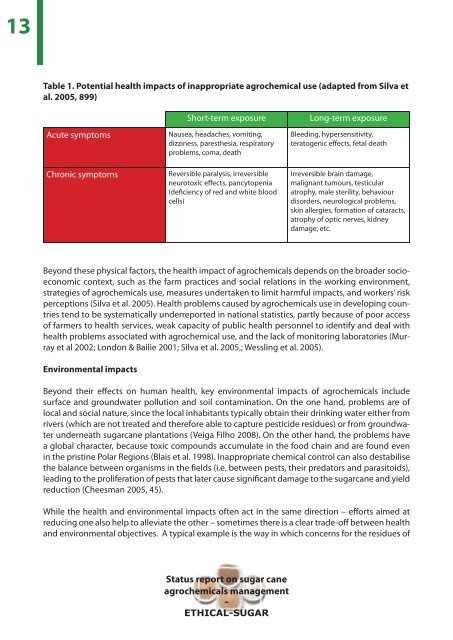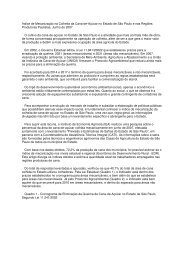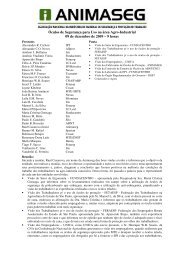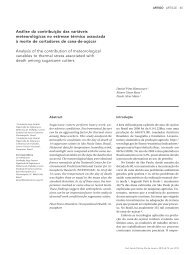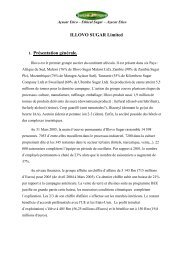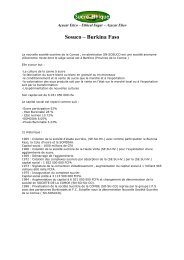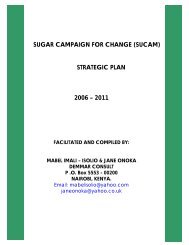Status report on sugar cane agrochemicals ... - Sucre Ethique
Status report on sugar cane agrochemicals ... - Sucre Ethique
Status report on sugar cane agrochemicals ... - Sucre Ethique
Create successful ePaper yourself
Turn your PDF publications into a flip-book with our unique Google optimized e-Paper software.
13<br />
Table 1. Potential health impacts of inappropriate agrochemical use (adapted from Silva et<br />
al. 2005, 899)<br />
Acute symptoms<br />
Chr<strong>on</strong>ic symptoms<br />
Short-term exposure L<strong>on</strong>g-term exposure<br />
Nausea, headaches, vomiting,<br />
dizziness, paresthesia, respiratory<br />
problems, coma, death<br />
Reversible paralysis, irreversible<br />
neurotoxic e� ects, pancytopenia<br />
(de� ciency of red and white blood<br />
cells)<br />
<str<strong>on</strong>g>Status</str<strong>on</strong>g> <str<strong>on</strong>g>report</str<strong>on</strong>g> <strong>on</strong> <strong>sugar</strong> <strong>cane</strong><br />
<strong>agrochemicals</strong> management<br />
-<br />
ETHICAL-SUGAR<br />
Bleeding, hypersensitivity,<br />
teratogenic e� ects, fetal death<br />
Irreversible brain damage,<br />
malignant tumours, testicular<br />
atrophy, male sterility, behaviour<br />
disorders, neurological problems,<br />
skin allergies, formati<strong>on</strong> of cataracts,<br />
atrophy of optic nerves, kidney<br />
damage, etc.<br />
Bey<strong>on</strong>d these physical factors, the health impact of <strong>agrochemicals</strong> depends <strong>on</strong> the broader socioec<strong>on</strong>omic<br />
c<strong>on</strong>text, such as the farm practices and social relati<strong>on</strong>s in the working envir<strong>on</strong>ment,<br />
strategies of <strong>agrochemicals</strong> use, measures undertaken to limit harmful impacts, and workers’ risk<br />
percepti<strong>on</strong>s (Silva et al. 2005). Health problems caused by <strong>agrochemicals</strong> use in developing countries<br />
tend to be systematically under<str<strong>on</strong>g>report</str<strong>on</strong>g>ed in nati<strong>on</strong>al statistics, partly because of poor access<br />
of farmers to health services, weak capacity of public health pers<strong>on</strong>nel to identify and deal with<br />
health problems associated with agrochemical use, and the lack of m<strong>on</strong>itoring laboratories (Murray<br />
et al 2002; L<strong>on</strong>d<strong>on</strong> & Bailie 2001; Silva et al. 2005,; Wessling et al. 2005).<br />
Envir<strong>on</strong>mental impacts<br />
Bey<strong>on</strong>d their e� ects <strong>on</strong> human health, key envir<strong>on</strong>mental impacts of <strong>agrochemicals</strong> include<br />
surface and groundwater polluti<strong>on</strong> and soil c<strong>on</strong>taminati<strong>on</strong>. On the <strong>on</strong>e hand, problems are of<br />
local and social nature, since the local inhabitants typically obtain their drinking water either from<br />
rivers (which are not treated and therefore able to capture pesticide residues) or from groundwater<br />
underneath <strong>sugar</strong><strong>cane</strong> plantati<strong>on</strong>s (Veiga Filho 2008). On the other hand, the problems have<br />
a global character, because toxic compounds accumulate in the food chain and are found even<br />
in the pristine Polar Regi<strong>on</strong>s (Blais et al. 1998). Inappropriate chemical c<strong>on</strong>trol can also destabilise<br />
the balance between organisms in the � elds (i.e. between pests, their predators and parasitoids),<br />
leading to the proliferati<strong>on</strong> of pests that later cause signi� cant damage to the <strong>sugar</strong><strong>cane</strong> and yield<br />
reducti<strong>on</strong> (Cheesman 2005, 45).<br />
While the health and envir<strong>on</strong>mental impacts often act in the same directi<strong>on</strong> – e� orts aimed at<br />
reducing <strong>on</strong>e also help to alleviate the other – sometimes there is a clear trade-o� between health<br />
and envir<strong>on</strong>mental objectives. A typical example is the way in which c<strong>on</strong>cerns for the residues of


